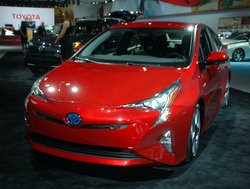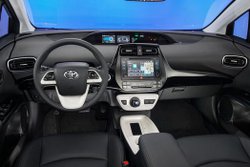The Leader Tries a New Look & Approach

The Toyota Prius has spent the past decade and a half searing its image into the American public as the leading eco-car. Now, with its fourth generation, it’s trying to shift gears. The 2016 Toyota Prius doesn’t give up anything in its environmental credentials—it still gets 50+ mpg and features the latest version of Toyota’s Hybrid Synergy Drive—but the emphasis for the new model is on aggressive styling and improved performance.
Toyota went as far as buying million-dollar-a-minute airtime on the Super Bowl to push the Prius’ new image. The ad tried to pose the new Prius as a getaway car for a group of hapless bank robbers. The company has since made the ad into a serial with follow-on episodes. Toyota executives said it remains to be seen whether the ad has had any impact on floor room traffic or sales, since the cars are just arriving at dealers in volume.
Styling Upgrade
The styling definitely takes the formerly sedate Prius into new territory with extreme angles that makes the car look like origami has been applied to its sheetmetal. It’s a take-or-leave-it approach not usually seen from Toyota, but is the company’s way of helping Prius regain its leadership position in light of declining sales and increased competition. The Prius was the best-selling car in California for several years, but last year dropped to third behind two Honda models.
While this “less egg-like” styling is designed to catch a broader swatch of buyers, the core of the Prius remains fuel economy. This year it will have two levels—the base Prius (labeled Prius Two

Eco) promises 58 mpg city / 53 mpg highway and 56 mpg combined. Non-Eco models offer 54 city / 50 highway / 52 combined. Its 1.8-liter four-cylinder Atkinson cycle engine turns out 95 hp; with its 53 kW electric motor the net horsepower hits 121. An electronically controlled continuously variable transmission routes the power to the wheels. Energy from its regenerative braking system is storing in a 6.5 amp-hr battery (nickel-metal-hydride in the base model and lithium-ion in the upscale models).
The drivetrain shows some upgrades from the past, but the suspension received a complete reworking. Again, the goal is to take the Prius into new territory, one where handling is a factor and the car could be described as “dynamic.” The Prius became the first car Toyota produced on its new global architecture, which resulted in a longer, lower and wider car. Lowering the center of gravity does lend the car a better feel on the road, but the Prius’ road manners remain solidly in the tame sedan category. The independent MacPherson strut front suspension and double wishbone rear are more supple, but the narrow standard tires (P195/65R15) will keep the Prius from being mistaken for a sports car.

A collection of advanced technology bundled as Toyota Safety Sense was added to the 2016 Toyota Prius. Included are automatic pre-collision braking, pre-collision system with pedestrian detection; lane departure alert with steering assist; full-speed dynamic radar cruise control and automatic high beams.
Six Grades of Prius
The six Prius “grades” start at $24,200 (for the Prius Two) and go up to $30,000 for the Prius Four Touring. Delivery, processing and handling adds $835. The 2016 Toyota Prius also will have Toyota Care standard, which covers normal factory-scheduled maintenance for two years or 25,000 miles.
Clean Fleet Report is looking forward to a longer drive of the 2016 Toyota Prius soon. At that point we should be able to give a more detailed report on how

improved the handling is and how close the real world fuel economy is to the exceptional numbers the car reports on the EPA cycle.
Related Stories You Might Enjoy:
Road Test: 2016 Hyundai Sonata Hybrid
Road Test: 2015 Volkswagen Jetta Hybrid
Unveiled: 2016 Toyota Prius
Road Test: 2015 Honda Accord Hybrid
Comparison Road Test: 2014 Toyota Prius & Prius Plug-in
Disclosure:
Clean Fleet Report is loaned free test vehicles from automakers to evaluate, typically for a week at a time. Our road tests are based on this one-week drive of a new vehicle, which does not address issues such as long-term reliability or total cost of ownership. In addition we are often invited to manufacturer events highlighting new vehicles or technology, during which we may be offered free transportation, lodging or meals. We do our best to present our unvarnished evaluations of vehicles and news irrespective of these inducements. Our focus is on vehicles that offer the best fuel economy in their class or are among the top mpg vehicles on the market. In addition, we aim to offer reviews and news on advanced technology and the alternative fuel vehicle market. We welcome any feedback from vehicle owners and are dedicated to providing a forum for alternative viewpoints. Please let us know your views at publisher@cleanfleetreport.com.

0 thoughts on “First Drive: 2016 Toyota Prius”